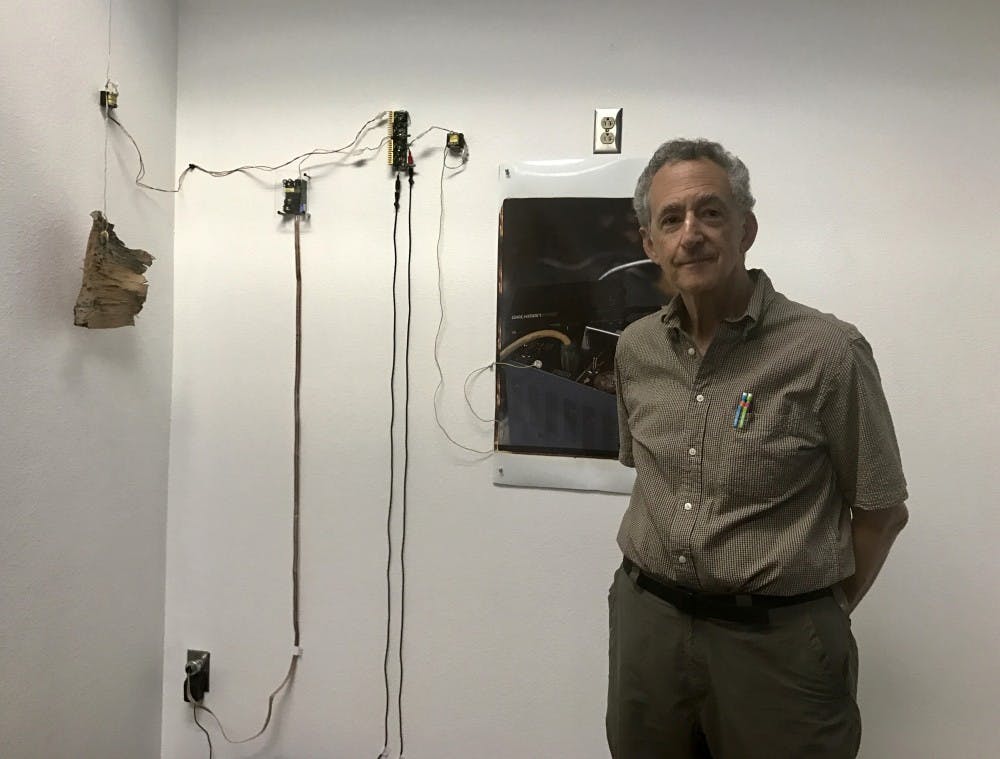A professor and sound artist who recently debuted 40 years of his work at the West campus said he came to ASU not only for the sunny weather, but for the classroom diversity that he said no other university could offer.
Professor Richard Lerman's Sound Art Works exhibition displayed his work from the last 40 years as a sound artist at ArtSpace West gallery.
Lerman gained an interest in sound art in the early 60s. He soon met John Cage, a renowned American composer who opened the door to observing sounds and electroacoustic music.
David Tudor, an American pianist and composer of experimental music, suggested that Lerman must learn how to make his equipment because of the lack of technology in the mid 20th Century. Lerman makes most of his own equipment which is seen throughout the exhibition with wires hanging out. In the featured display "Session: 20x 24 Photographs," he uses the space between the wall and photograph to produce sound.
“I think that the wires need to visible because it is a very physical thing, sound," Lerman said.
Dr. Jeffery Kennedy is a committee member of the Interdisciplinary Arts and Performance (IAP) faculty. He promotes the exhibitions at the ArtSpace gallery, Second Stage West, and other locations at West. Kennedy has worked with Lerman for over 17 years and admires the different types of platforms Lerman uses.
"I think the interdisciplinary nature of Richard's work using images, videos and performance, is interesting, innovative, and his commitment to his subject/topic is second to none," Kennedy said.
His work involves a variety of tools to achieve the sound he wants. He uses carbon fiber rods, piezoelectric devices that can capture the vibrations of sounds, hydrophones to get sounds underwater and many more.
Richard Lerman's Travelon Gamelon - Promenade from STEIM Amsterdam on Vimeo.
Lerman travels thousands of miles to gather sounds. He has traveled to India, the Arctic Circle, Austria and Finland. Some of these trips were based around a topic or event from which Lerman wanted to gather sound. In South America, Lerman collected video and sound from a human rights protest which is in the display "Sonic Journeys 3."
“You know that expression, what you see is what you get? What I say is what you hear is what you get,” Lerman said.
Lerman came to ASU to because of the better pay and because he admired the diversity of the classes. He has students who are single parents, first generation, older and have different backgrounds. At ASU, he has more opportunities to teach what he wants, such as his class called Art and War.
“I can do things that integrate the political, social and the science,” Lerman said.
IAP junior Ivelisse Chaug is the gallery coordinator at the West Campus ArtSpace. Chaug works with the artist for installation, deinstallation and gallery guards. She has worked closely with Lerman for about two years which has made her learn more about sound art.
“From him you get to learn all that context behind the work and you get to learn sound design,” Chaug said.
Lerman continues to make sound art to bring attention to the world he observes.
"It lets people hear and see things and they begin to put it into their own ways of thinking. Maybe it will inspire them to do more research," Lerman said.
Reach the reporter at kbenalli@asu.edu or follow @kallebenallie on Twitter
Like The State Press on Facebook and follow @statepress on Twitter




